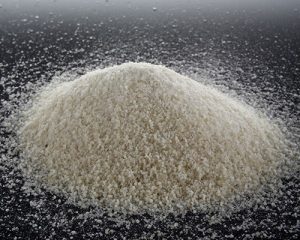
Poly Anionic Cellulose (PAC) is a type of water-soluble cellulose that is an ether derivative manufactured by the chemical modification of natural cellulose. It is an important water-soluble cellulose ether. Poly Anionic Cellulose finds important applications in offshore exploration & production, drilling & salt well operations in the upstream oil & gas industry. It is a white or yellowish, odorless powder that is hygroscopic, tasteless, and non-toxic. It is water-soluble at both low as well as high temperatures and forms a thick liquid when it’s dissolved in water. Poly Anionic Cellulose displays high stability in high-temperature applications and exhibits high resistance to salty environments as well it has also been found to possess anti-bacterial properties. Poly Anionic Cellulose slurry displays superior fluid loss reducing capability, rejection capabilities, and high-temperature tolerance in different applications. Moreover, Poly Anionic Cellulose finds applications across a diverse range of industries for a big range of uses apart from the oil and gas industry. For example, food and beverage pharmaceutical, chemical, plastic, and polymer are some of the end-use industries worth noting
Related Projects: – Project Reports & Profiles
Key Trends and Market Drivers of PAC
To search for hydrocarbons to ensure a smooth, long-term supply of crude oil and natural gas and energy sufficiency petroleum exploration and production companies have strategized to procure and develop offshore oil and gas fields in deeper waters and harsh environment offshore conditions. It has increased the demand for Poly Anionic Cellulose as it has significant application in context to altering drilling fluid properties in favor of ensuring smooth oil field services operations. Poly Anionic Cellulose gives superior filtration control and supplementary viscosity in most water-based drilling fluids, concerning other oil field chemicals. It has been an imperative factor driving the growth of the Poly Anionic Cellulose
Market.
Related Books:- BOOKS & DATABASES
In present times, there has been an increase in the demand for Poly Anionic Cellulose from the fast-growing food and beverage industry. It is because Poly Anionic Cellulose has demonstrated to be more safe and comparison to other chemicals as a food additive, thereby gaining preferential use. Poly Anionic Cellulose is also been finding an increased usage in water purification processes in the food and beverage industry.
Global Demand of Poly Anionic Cellulose
Worldwide the market for Poly Anionic Cellulose PAC is anticipated to grow at a CAGR of roughly 5.3 % over the next five years and will reach 22 million US $ in 2024, from 17 million US $ in the year 2019.Poly Anionic Cellulose is also been widely used as a stabilizer and thickener in food production. Such as jelly products and ice creams are stabilized and thickened to a large extent with the usage of Poly Anionic Cellulose (PAC). PAC is advantageous because of its compatibility to be canned and stored for extended periods, thereby becoming a popular choice as a food stabilizer. It is also being used widely to stabilize gravies and fruit and vegetable juices. The rapid growth of the food and beverages industry has also been contributing to the market growth of Poly Anionic Cellulose at a global level. In the pharmaceutical industry, Poly Anionic Cellulose has been gaining importance as an emulsifier and a stabilizer in the manufacture of injectable medicines and tables due to its effective bonding properties.
Related Videos: – Chemicals (Organic, Inorganic, Industrial)
Conclusion
Niir project consultancy services (NPCS) has a project report named “Poly Anionic Cellulose (PAC)” The report talks about all the important aspects of the Poly Anionic Cellulose market. The Analyses of the market, confirms the availability of various necessities such as plant & machinery, raw materials to forecasting the financial requirements. The report also includes assessing market potential, negotiating with collaborators, investment decision making, corporate diversification planning, etc. You can get this and many other project reports on the official website of NPCS.
Related Project:- Polyanionic Cellulose (pac)
Noo_Art20